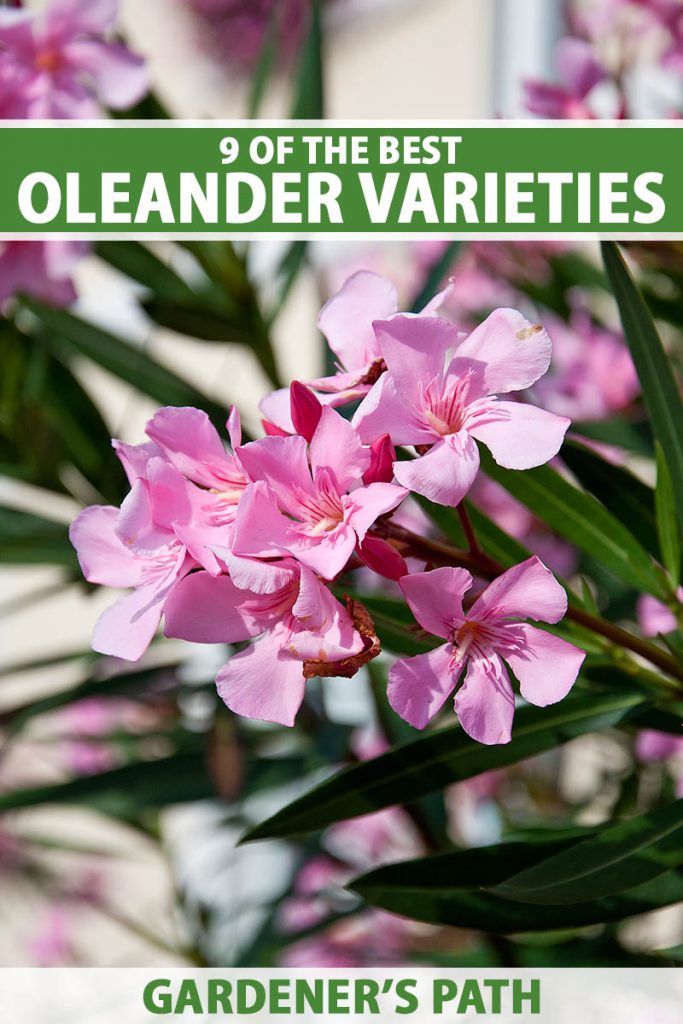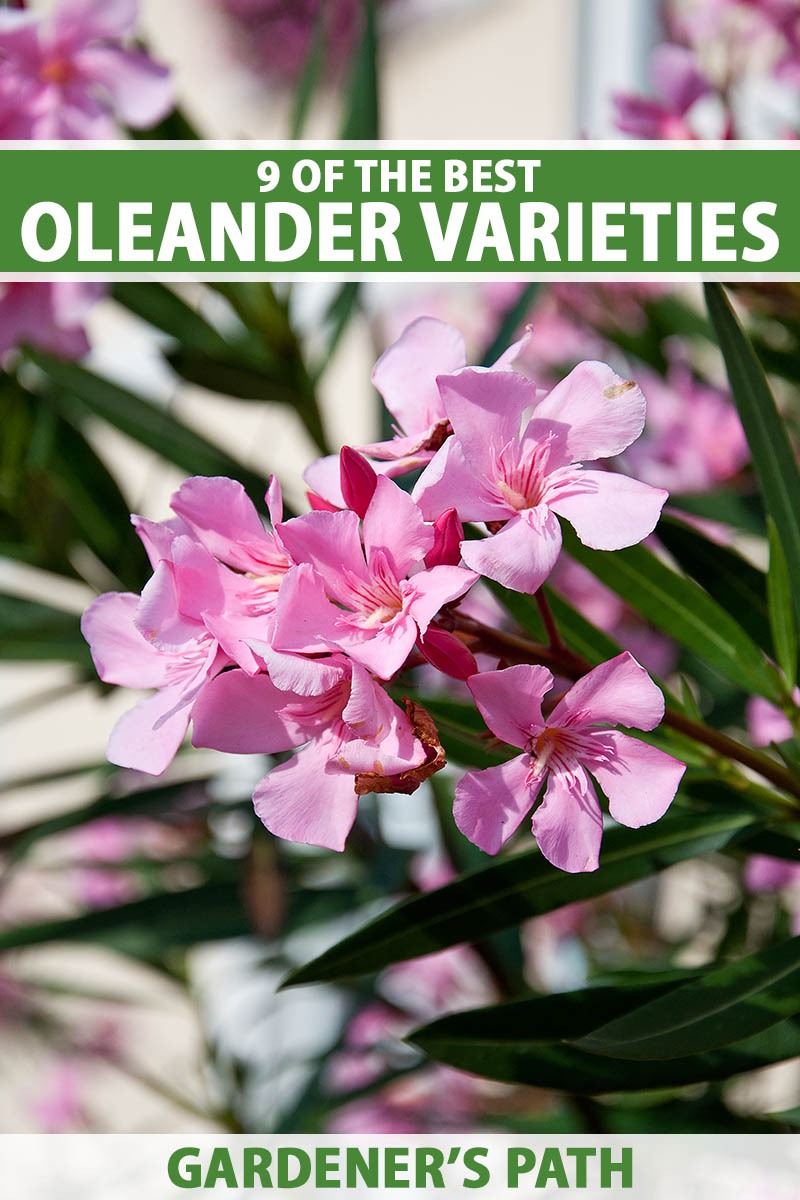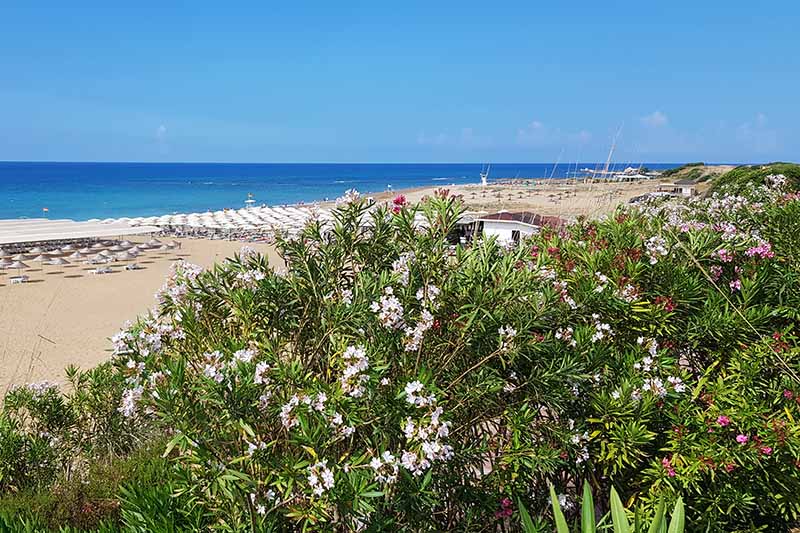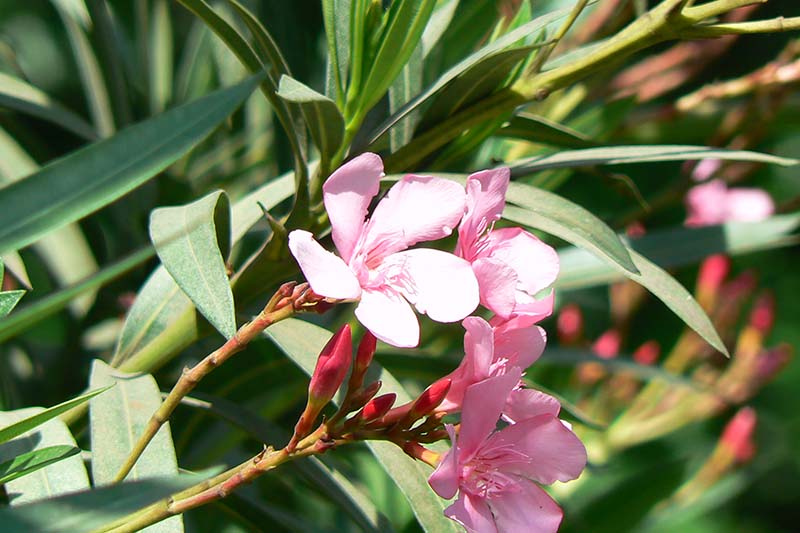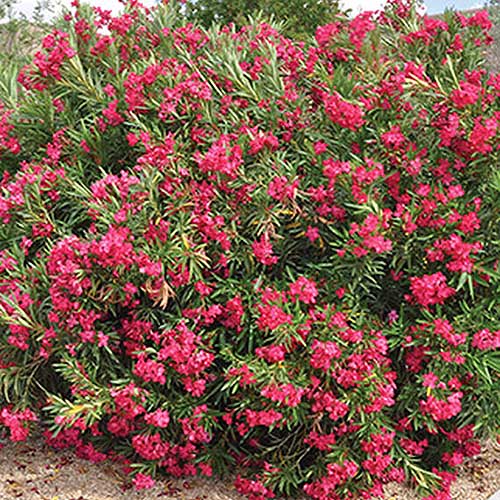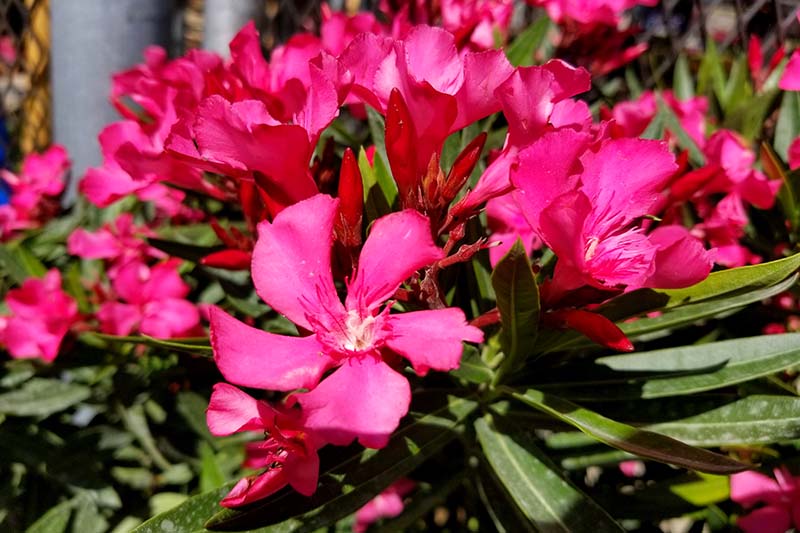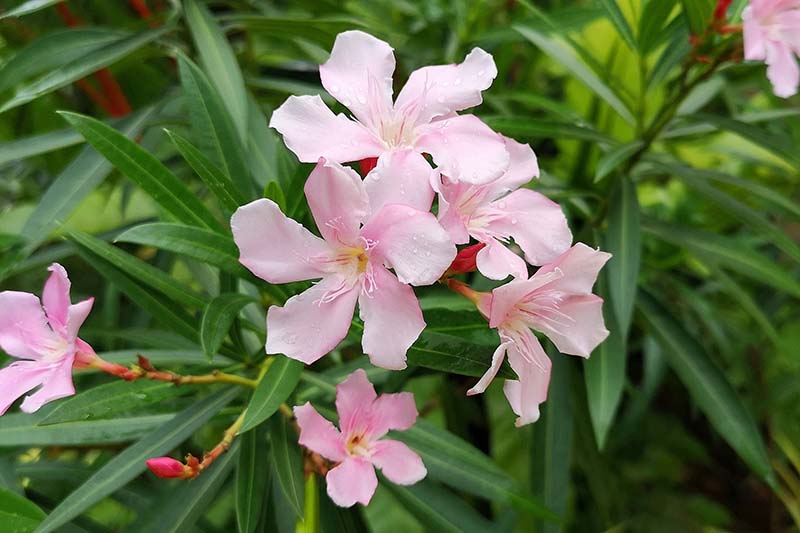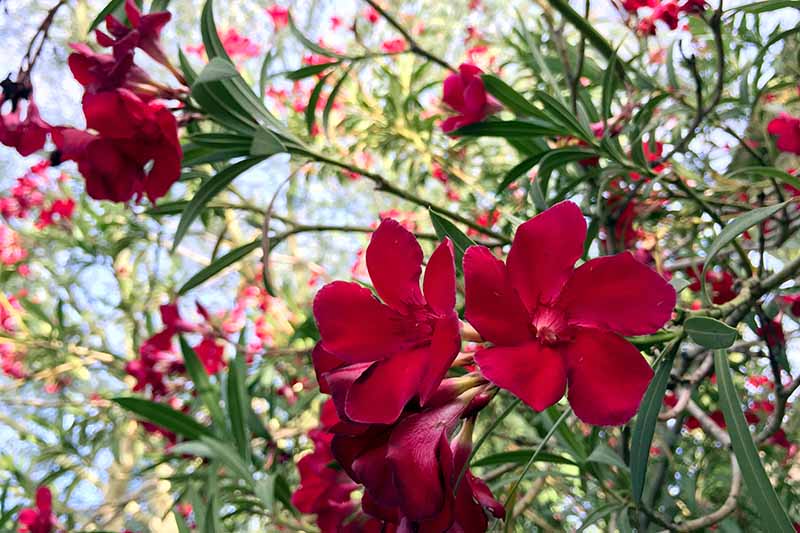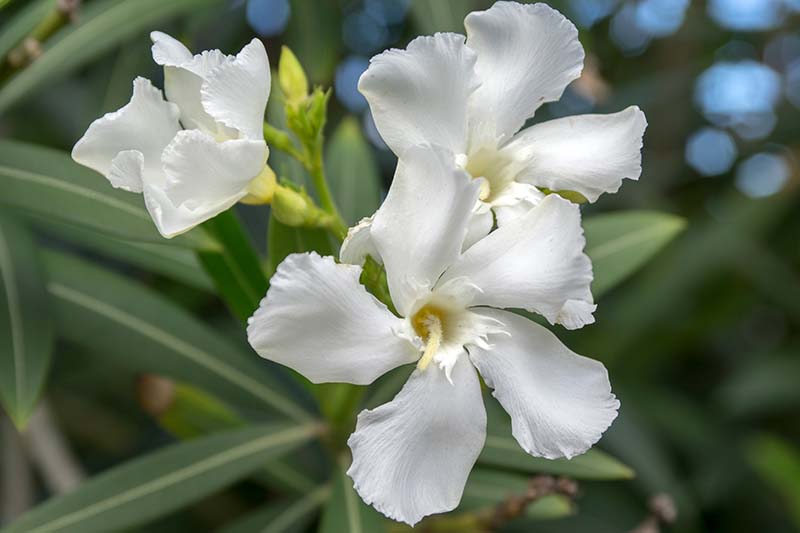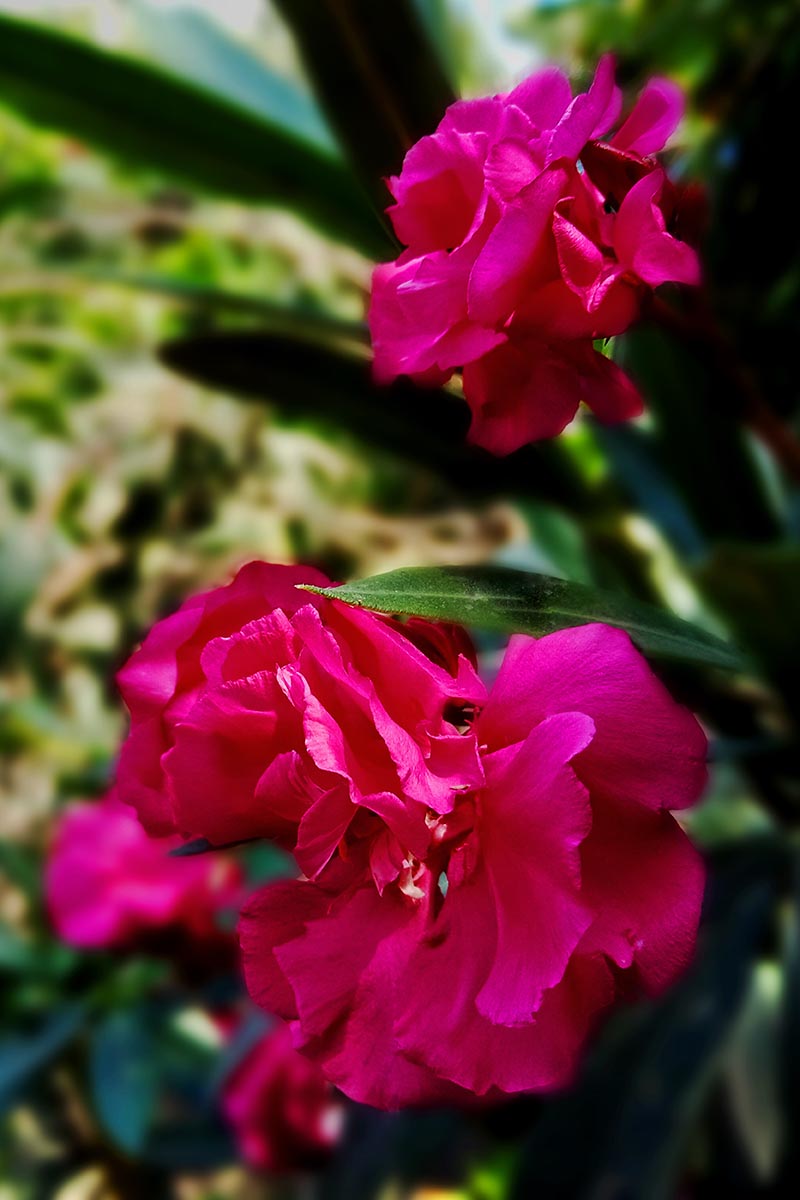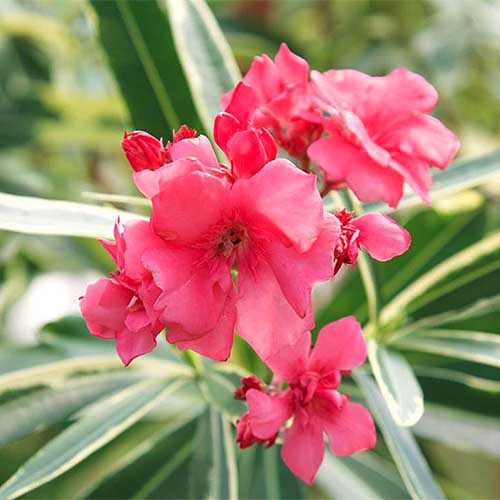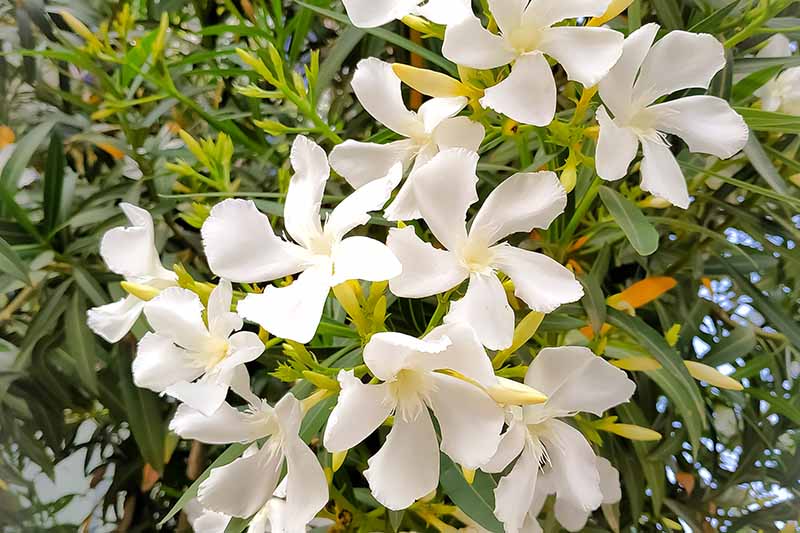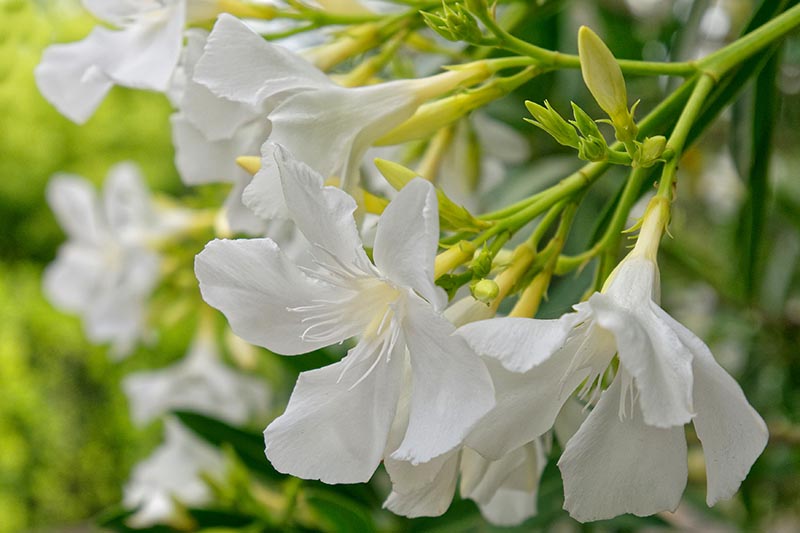Me, I’d argue only that they could have been talking about oleander when they said it. Like a fine fabric, these evergreen flowering shrubs are beautiful and luxurious, with their profusion of colorful blooms and blade-shaped green or variegated leaves. But, like that iron fist, Nerium oleander are also tough as nails. We link to vendors to help you find relevant products. If you buy from one of our links, we may earn a commission. They do need a little extra help in colder climates, but they’ll do just fine if you grow them indoors or plant them in containers to bring inside when freezing temperatures loom.
There are many types of Nerium to choose from, especially if you’re willing to choose varieties that arrive as bare root stock, or to grow others from seed. You might want to base your selection on their bloom color. These beauties have flowers in shades of cream, pink, red, salmon, and even purple. We won’t be talking about yellow oleander (Cascabela thevetia) here, because it’s a different species with its own options and areas where it thrives. You can also choose from dwarf, mid-size, or tall types, depending on whether you plan to grow oleander in containers, as part of a hedge or privacy fence, or maybe as a single-trunk tree that reaches 15 feet or more.
As you’re pondering any of these options, please, please, heed this warning. The best oleander variety to grow is no variety at all if you’re growing where children, unsuspecting adults, pets, or stock animals might ingest them. All parts of this evergreen shrub is poisonous if consumed, with each part of the plant containing cardiac glycoside. It causes gastric distress, arrhythmias, shock, and heart failure, and can be fatal if ingested. When you have small children who live with you or have access to your garden, you should probably choose some other type of flowering shrub. Ditto if your garden or landscape where cats, dogs, horses, stock animals, or even rabbits or budgies might gain access to any oleander you plant. But if you’ve planned ahead to prevent accidental poisoning, it’s a delight to choose from some of these fun, pretty, and darn tough varieties. Allow me to present the following options for your consideration:
1. Apple Blossom
Such delicacy! The two- to three-inch, five-petaled, pastel pink blooms on ‘Apple Blossom’ are something you’ll want to gaze at time and again. Since these evergreens bloom strong from late spring through early autumn, you’ll have plenty of opportunity. ‘Apple Blossom’ is known as one of the toughest pink cultivars. I’ve heard it described as “indestructible” more than once. It’s hardy in Zones 8-11. This tall oleander forms a large, rounded shrub that looks great in a privacy screen or alongside the driveway (only if you plant it well away from curious kids, though). It’s a wonderful choice for training into a multi- or single-trunk tree with a crown of blooming foliage at the top of each main stem, too. It will reach 10 to 18 feet either as a tall shrub or specimen tree. The light pink flowers also look great in a coastal windbreak, especially at sunset, The shrubs themselves tolerate both salt and humidity in a warm seaside spot.
5. Hardy Pink
I say this affectionately, but adding the word “hardy” to an oleander cultivar name is redundant. They’re all hardy, to an extreme, able to survive drought and high temps, and even salt air. If someone did say that about ‘Austin Pretty Limits,’ they were clearly overruled. But don’t let the frivolous name keep you from noticing the striking beauty of this shrub, with its bright pink blooms and dense evergreen foliage.
‘Austin Pretty Limits’ Introduced by well-known hybridizer Kevin Hurd, ‘Austin Pretty Limits’ grows from four to six feet tall and spreads four to five feet. It’s hardy in Zones 8-11. Its compact form, laden with those colorful-but-elegant blooms, makes it an ideal choice for a seaside garden, West Coast sidewalk border, or Southern stateside mounding hedge. It’s container ready, too. You can easily schlep it inside to overwinter in areas where gardeners can only dream of sultry Texas growing conditions or watching “Austin City Limits” at a live taping. ‘Austin Pretty Limits’ is available from Burpee.
3. Calypso
Ah, the ‘Calypso.’ I love the soulful John Denver single with this name, and have the highest esteem for Jacques Cousteau’s research boat, which inspired the song.
As an oleander, though, ‘Calypso’ has its own distinct appeal. An evergreen, it produces profusions of single, magenta blooms on extra-vigorous plants. To me, this cultivar says, “Florida seaside town,” because I’ve seen it on road trips so often. In the Sunshine State, it brightens up ocean-side landscapes, median strips on the highways and byways, and even the occasional strip mall parking lot. But Florideans aren’t the only ones who can sing to the spirit of ‘Calypso.’ It will grow 10-18 feet and spread 10-15 feet in other areas, too. It does well – flourishes in fact – in scalding weather, and is hardy as an outdoor plant in Zones 8-11a. ‘Calypso’ Many fans train them to grow as multi-trunk trees, with the showy blooms covering the tops of the stems. Centered five feet apart, these ‘Calypso’ specimens create a beautiful flowering windbreak or privacy screen in West Coast, southern, or coastal areas where the temps stay above about 20°F year-round.
4. Dwarf Red
I was going to say this is “snack size,” but no. No snacking on oleander, no matter the variety, even wee shrubs that grow to just five or six feet tall and spread three feet wide. They are poisonous if ingested.
So let’s say these are “mini me” versions of the tall red types. And while there are specific cultivars that are dwarf reds, like ‘Little Red,’ most growers and seed sellers simply refer to all the small varieties with dark green leaves and crayon-red blooms as “dwarf red.” They commonly bloom starting in late spring and continuing on through early autumn. In zones 8-10, they may even bloom year-round, though they’ll have more flowers going in the warmest months. These minis are swell picks for patio performance (say that three times fast…), and as container ornamentals that overwinter indoors in Zones 4-11. Dwarf Red Or, if you live on the West Coast, in the sunny South, or in certain coastal areas, you can grow them as a bloomin’ border or low hedge.
But ‘Hardy Pink’ is so beautiful and undemanding that we’ll forgive it for its repetitive name. Also known as ‘Pink Beauty’ in the oleander stronghold of Galveston, Texas, this cultivar produces clusters of large, five-petaled, pink flowers with a light fragrance. Its buds are distinctive, with an elongated hot-air balloon shape and swollen appearance. Reliably cold-tolerant to about 20°F, ‘Hardy Pink’ is unique in that it has been known to rebound the following season after suffering stem or leaf damage from single digit temperatures. In other words, while it’s generally considered as being hardy in Zones 8-11, it may survive handily in the colder winters of Zones 7a and 7b, or even Zone 6 in a well-protected area. I’m not saying you have to run that risk, though. It’s probably best to take ‘Hardy Pink’ indoors in cold temps, so it doesn’t have to prove itself worthy of the name.
6. Red
While there are specific cultivars of this type, namely ‘Hardy Red,’ you’re most likely to spy seeds or live plants with the generic name “red oleander.”
According to the experts at the Clemson Cooperative Extension, the red standards are the most hardy types among all the Nerium, possibly cold tolerant down to Zone 7b. Their mature height typically tops out at 8 to 12 feet, and they’ll spread almost as wide. This type has large, single blooms in a shade I like to call “plain old red,” similar to that found on the American flag or “Pretty Woman” Vivian Ward’s dress. They’re understated compared to some of the splashy pinks and corals available, but the effect is sultry, not dull.
Frenchman Félix Sahut introduced this tall (or at least pretty tall) oleander in 1873, according to the Austrian authority, Oleander Haus. It’s recognized by its mild fragrance and single, pure white blooms with subtly-yellow “throats” at their centers. The flowers do look a bit like the summer habits of European nuns from back in the day, but that could just be my own flight of fancy. The cultivar’s name also inexplicably reminds me of Elvis singing “Little Sister” (as in, “Little sister, don’t”), so maybe we shouldn’t take my theories about this name too seriously… ‘Sister Agnes’ But it is notable that arborists and home gardeners commonly train ‘Sister Agnes’ to grow as a single-trunk tree, if you’re interested in that landscape look. She’ll reach 10 to 18 feet tall and spread 10 to 15 feet.
8. Twist of Pink
The leaves offer the unusual twist here. They’re a variegated cream and green, with the light streaks running vertically down the blade-shaped leaves.
The ruffled, deep, double pink blooms are splashy without being over the top, more of a “Pretty in Pink” vibe than a psychedelic hue. The shrub’s mature height of six to eight feet makes it mid-size, ideal for mounding, hedges, or a discreet privacy fence.
‘Twist of Pink’ Although this shrub is part of the Southern Living Plant Collection, which may make you think of the sweltering states, it’s fairly cold tolerant, hardy to the 10 to 20°F range. On the flip side, it’s still drought-resistant and can tolerate prolonged periods of heat once it’s established. ‘Twist of Pink’ is available in two-gallon containers from Home Depot.
9. White Sands
Nature Hills Nursery does sell a live plant they refer to as simply “white oleander,” and it grows to five to eight feet and spreads four or five feet. But there are also specific cultivars that are compact, dwarf-height, and cream-colored. One of the most widely available is this ‘White Sands.’
It produces abundant clusters of white, single-bloom flowers starting in spring and carrying on through early autumn. In warm weather locales, it will bloom all year long. This sweet white shrub is a little less cold-tolerant than some of the others, hardy only in Zones 10 and 11. But it still has that wonderful trait, like other Nerium, of blooming even more profusely as temperatures soar, and without requiring any additional fertilizer. It grows to between four and six feet and spreads about the same distance, making it a swell option for containers to overwinter indoors, or as a low-growing, flowering hedge in warm weather areas.
Pick Your Favorite, Hands-Free
Thinking about these gorgeous, tough, fast-growing varieties is enjoyable, but do take a quick break from the pleasantry to determine whether it’s safe for you to grow these poisonous beauties at your place.
Once all safety precautions have been met, you can return to selecting the best type for you based on color, height, bloom type, or what’s available to grow from a cutting in your neck of the woods. Or maybe you’ve already been there, done that? Have you successfully grown or trained one of these varieties, or another one I didn’t touch on here? (Pun purely intentional.) If so, kindly scroll down to the comment section and add any findings or tips you have for aspiring oleander container gardeners and landscapers. And if you enjoyed perusing the different selections available and would like to learn more about growing oleander, give these articles a look next:
How to Grow and Care for Oleander Shrubs Gardeners, Beware! All Parts of Oleander Are Poisonous When Eaten How to Overwinter Oleander Shrubs
© Ask the Experts, LLC. ALL RIGHTS RESERVED. See our TOS for more details. Product photos via Burpee, CaliHome Garden, DIYLandscaping, Home Depot, and PlantVine. Uncredited photos: Shutterstock.
